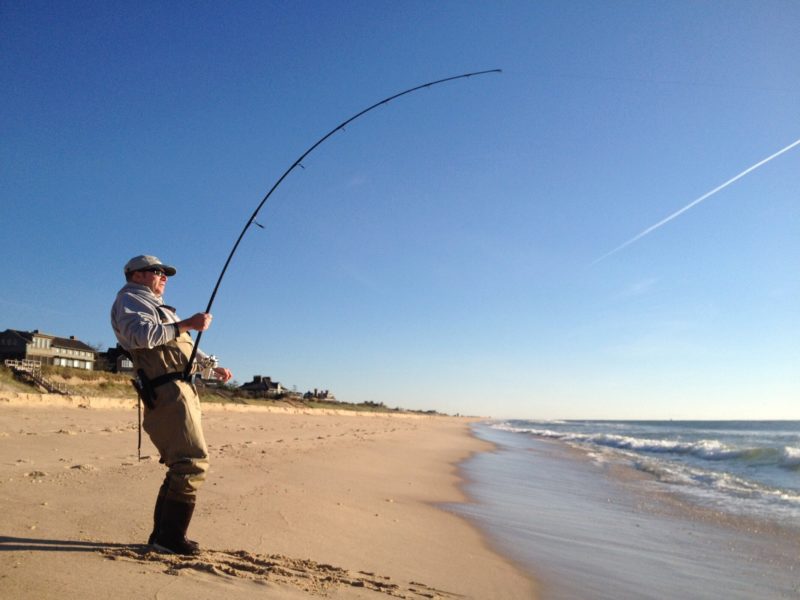

In God we trust. Everyone else, sharpen your hooks.
This being the quiet season for fishermen — unless you’re one of the die-hards who is out cutting holes in the ice on a frozen pond or hunting white perch in the brackish — this is a good time to focus on repairing or replacing tackle.
Sacrificing two hours on the couch now could save you from ruining a beautiful day, or night, on the boat or at the beach by letting a fish of a lifetime get away.
I’ve always been a penny-pincher when it comes to tackle. I recycle leader material, save the swivels from wrecked bait rigs, pull the split rings off broken lures. I have roughly 400 pounds of old bucktail heads in my basement that someday I see myself getting around to repainting and whipping with new hair.
Frugality is good. Being cheap isn’t.
We fishermen spend so much money on fishing tackle but so often cheap out on the least expensive components. Custom rods, fancy reels, shiny lures that cost as much as dinner for two — none of them really makes a difference in catching 99.9 percent of fish.
The only things that really matter are the cheapest: hooks and line.
This week, line. Next week, hooks.
Since most everyone has switched over to braided line, replacing line isn’t quite as critical an annual (or monthly) chore as it used to be. While it is far more expensive than monofilament, braided line that hasn’t been raked over a rock or boat hull will last for years and probably winds up being cheaper if you consider the number of days of fishing you can expect to get out of it.
But you do have to pay a bit more attention to it to ensure that it is in battle-ready condition. It was easy to tell when mono was ready for the recycling bin: It faded and got cloudy as the sun degraded its polymers, and abrasions were hard to miss by just running the line through your fingers.
Not so much with braid. Unlike mono, simple exposure to the sun does not weaken the fibers of braid; it just bleaches out the colors. Braid can fade from the dark, lustrous green it is in the package (you should definitely be using green braid in our nutrient-rich local waters, even offshore, since it is by far the least visible) to gray and not lose any of its stopping power.
But you do have to be much more meticulous in checking braid for damage, since it is not as easy to see abrasions.
Every several outings, you should be checking the first 50 feet or so of your line for extensive abrasion from simple casting or the line being impacted into the sand of the beach by waves. If you encounter noticeable abrasions over a long length of the line, check your rod’s guides for nicks or cracks that could be damaging your line.
In the offseason, give the whole spool, or most of it, a closer look. No need to disassemble anything if you don’t have the energy — just lean the rod up against a table or chair and slowly pull the line through, one arm’s length at a time, giving it a good look for damage before you drop it to the floor (in a wide, loose pile so it’s easy to wind back up without tangling).
Make sure you can see the strands wrapped in a smooth twist. Damage could look like frizzing on a cheap sweater or a clearly broken filament of braid poking out from the rest. Anything out of the ordinary should be given a hard pull to ensure that it is not a structural weakness.
Usually, damage will be toward the top of the spool. A fray or problem well down into the spool is a drag, because it probably renders two long sections of valuable braid essentially useless.
For those penny-pinchers, if you lose a good section of line but still have a good half-spool full, stripping off the braid and putting some additional monofilament backing on the bottom is fine. (Most surf fishermen using the Van Staal reels have at least half their spool filled with mono, since these reels will hold easily four times as much braid as one would need to catch even the largest striped bass. If you change the mono every couple of years and make sure you are using a strong mono-to-braid knot, this will still be a solid tether if you happen to catch something that dumps line.)
Braid can be “flipped,” too, so that the line that has been deep in the spool and is basically like new is shifted to the top. You have to strip the line off onto some other spool, then onto a third, then wind it back onto the reel so the faded line at the top is at the bottom and the new line at the top.
This is an okay thing to do, but be honest with yourself about the condition of the line. Don’t think that burying a frayed section deep in the spool is the same as putting new line on — the $25 you save now will be gotten back in spades by the Fish Gods when that trophy starts pulling line.
Next week (two weeks, actually), we’ll go through the need to replace hooks on your lures.
In the meantime, catch ’em up. See you out there.
 More Posts from Michael Wright
More Posts from Michael Wright